Cooperation of a Non-Linear Receiver with a Three-Phase Power Grid
Abstract
:1. Introduction
1.1. Literature Review
- an analysis of the impact of a non-linear receiver on a single-phase power grid [22],
- development of a method for improving the power factor in a four-wire system with non-sinusoidal periodic waveforms—in particular, the method of determining the coefficients of reactive compensators using the Y/Δ transformation [2].
1.2. Research Gap
2. Mathematical Description of the Circuit
- vector ia—the active component of the current, depending on the P active power of the receiver and, at the same time, on the resultant of the equivalent conductance Ge of the receiver. The value of this conductance describes a pure-resistive receiver, and it is directly proportional to the active power P and inversely proportional to the square of the RMS value of the voltage . The instantaneous and effective value of this component is:
- vector is—the scattered component of current; it appears when the Ge(n) equivalent conductance of the receiver changes with the order of harmonics. The instantaneous and effective value of this component is:
- vector ir—the reactive component of current; it appears when there is a non-zero phase shift between the vectors of current i(n) and voltage u(n), for any harmonic in any phase. The condition for this shift to exist is a non-zero equivalent susceptance Be(n) ≠ 0.
- vector iu—the unbalanced component of current; it appears in the case of non-zero unbalanced admittance Yu(n) ≠ 0.
- P—active power, W,
- S—apparent power, VA,
- Q—reactive power, var,
- Du—unbalanced power, VA,
- Ds—scattered power, VA.
- vector of the active component of current for the direction from D to C:
- vector of the scattered component of current for the direction from D to C:
- vector of the reactive component of current for the direction from D to C:
- vector of the unbalanced component of current for the direction from D to C:
- vector of the component of current generated by the non-linear receiver for the direction from C to D:
- (a)
- for the flow of energy from a non-linear receiver to the source
- (b)
- for the flow of energy from the source to the non-linear receiver
3. Electronic Measuring Methods of Active Power
3.1. Calculation of Active Power Resulting from an Analysis of the Waveform of the Instantaneous Power Signal
- -
- fundamental component of the active power
- -
- harmonic component of the active power
3.2. Determination of Individual Powers from Basic Power Equations for Sinusoidal Waveforms
3.3. Measurement of Fundamental Component of the Active Power
4. Example and Discussion
5. Conclusions
Author Contributions
Funding
Institutional Review Board Statement
Informed Consent Statement
Data Availability Statement
Conflicts of Interest
Symbols
| P | active power, W |
| Q | reactive power, var |
| S | apparent power, VA |
| SBu | apparent power according to the Bucholz theory, VA |
| SG | geometric apparent power, VA |
| SAr | arithmetic apparent power, VA |
| Du | unbalanced power, VA |
| Ds | scattered power, VA |
| u=u(t) | vector of instantaneous voltages in a three-phase system, V |
| U | vector of complex voltages in a three-phase system, V |
| i=i(t) | vector of instantaneous currents in a three-phase system, A |
| I | vector of complex currents in a three-phase system, A |
| i a | active component of current-three-phase vector, A |
| i s | scattered component of current-three-phase vector, A |
| i r | reactive component of current-three-phase vector, A |
| i u | unbalanced component of current-three-phase vector, A |
| iR, iS, iT | instantaneous values of line currents, A |
| uR, uS, uT | instantaneous voltage values relative to the virtual star point, V |
| Be | equivalent susceptance, S |
| ED | voltage source in D system, V |
| JC | current source in the mathematical model of the receiver, A |
| YC | receiver admittance, S |
| ZD | internal impedance of the source, Ω |
| Subscripts | |
| R,S,T,N | phase and neutral wires |
| D | a set of components describing the flow of energy from D to C system |
| C | a set of components describing the flow of energy from C to D system |
| Acronyms | |
| THD | Total Harmonic Distortion |
| CPC | Currents Physical Components |
| LPF | Low Pass Filter |
| HPF | High Pass Filter |
| FFT | Fast Fourier Transform |
References
- Smyczek, J.; Zajkowski, K. Simulation of overvoltages for switching off lagging load from mains. In Proceedings of the 2nd International Industrial Simulation Conference 2004, Malaga, Spain, 7–9 June 2004; pp. 278–281. [Google Scholar]
- Zajkowski, K. Two-stage reactive compensation in a three-phase four-wire systems at nonsinusoidal periodic waveforms. Electr. Power Syst. Res. 2020, 184, 106296. [Google Scholar] [CrossRef]
- Zajkowski, K. An innovative hybrid insulation switch to enable/disable electrical loads without overvoltages. In Proceedings of the International Conference Energy, Environment and Material Systems (EEMS 2017), E3S Web of Conferences, Polanica Zdrój, Poland, 13–15 September 2017; Volume 19. [Google Scholar] [CrossRef]
- Zajkowski, K.; Rusica, I. The method of calculating LC parameters of balancing compensators in a three-phase four-wire circuit for an unbalanced linear receiver. In IOP Conference Series: Materials Science and Engineering, Proceedings of the Innovative Manufacturing Engineering and Energy (IManEE 2019)—"50 Years of Higher Technical Education at the University of Pitesti"—The 23rd Edition of IManEE 2019 International Conference, 22–24 May 2019, Pitesti, Romania; IOP Publishing Ltd.: Bristol, UK, 2019; Volume 564, p. 12134. [Google Scholar] [CrossRef]
- Duer, S.; Zajkowski, K.; Scaticailov, S.; Wrzesień, P. Analyses of the method development of decisions in an expert system with the use of information from an artificial neural network. In Proceedings of the 22nd International Conference on Innovative Manufacturing Engineering and Energy—IManE&E 2018, MATEC Web of Conferences, Chisinau, Republic of Moldova, 31 May–2 June 2018. [Google Scholar] [CrossRef]
- Duer, S.; Zajkowski, K.; Harničárová, M.; Charun, H.; Bernatowicz, D. Examination of Multivalent Diagnoses Developed by a Diagnostic Program with an Artificial Neural Network for Devices in the Electric Hybrid Power Supply System “House on Water”. Energies 2021, 14, 2153. [Google Scholar] [CrossRef]
- Duer, S.; Rokosz, K.; Zajkowski, K.; Bernatowicz, D.; Ostrowski, A.; Woźniak, M.; Iqbal, A. Intelligent Systems Supporting the Use of Energy Devices and Other Complex Technical Objects: Modeling, Testing, and Analysis of Their Reliability in the Operating Process. Energies 2022, 15, 6414. [Google Scholar] [CrossRef]
- Krzykowski, M.; Paś, J.; Rosiński, A. Assessment of the level of reliability of power supplies of the objects of critical infrastructure. IOP Conf. Ser. Earth Environ. Sci. 2019, 214, 012018. [Google Scholar] [CrossRef]
- Siergiejczyk, M.; Pas, J.; Rosinski, A. Modeling of Process of Maintenance of Transport Systems Telematics with Regard to Electromagnetic Interferences. In Tools of Transport Telematics, Proceedings of the 15th International Conference on Transport Systems Telematics, TST 2015, Wrocław, Poland, 15–17 April 2015; Communications in Computer and Information Science; Mikulski, J., Ed.; Springer: Berlin/Heidelberg, Germany, 2015; Volume 531, pp. 99–107. [Google Scholar] [CrossRef]
- Siergiejczyk, M.; Pas, J.; Rosinski, A. Issue of reliability–exploitation evaluation of electronic transport systems used in the railway environment with consideration of electromagnetic interference. IET Intell. Transp. Syst. 2016, 10, 587–593. [Google Scholar] [CrossRef]
- Stawowy, M.; Rosiński, A.; Paś, J.; Klimczak, T. Method of Estimating Uncertainty as a Way to Evaluate Continuity Quality of Power Supply in Hospital Devices. Energies 2021, 14, 486. [Google Scholar] [CrossRef]
- Zajkowski, K. Settlement of reactive power compensation in the light of white certificates. In Proceedings of the International Conference Energy, Environment and Material Systems (EEMS 2017), E3S Web of Conferences, Polanica Zdrój, Poland, 13–15 September 2017; Volume 19. [Google Scholar] [CrossRef]
- Duer, S.; Rokosz, K.; Bernatowicz, D.; Ostrowski, A.; Woźniak, M.; Zajkowski, K.; Iqbal, A. Organization and Reliability Testing of a Wind Farm Device in Its Operational Process. Energies 2022, 15, 6255. [Google Scholar] [CrossRef]
- Czarnecki, L.S. Reactive and unbalanced currents compensation in three-phase circuits under nonsinusoidal conditions. IEEE Trans. Instrum. Meas. 1989, 38, 754–759. [Google Scholar] [CrossRef]
- Czarnecki, L.S. Energy flow and power phenomena in electrical circuits illusions and reality. Archiv Elektrotechnik 1999, 82, 0119–0126. [Google Scholar] [CrossRef]
- Czarnecki, L.S. Moce w Obwodach Elektrycznych z Niesinusoidalnymi Przebiegami Prądów i Napięć; Oficyna Wydawnicza Politechniki Warszawskiej: Warszawa, Poland, 2005. [Google Scholar]
- Czarnecki, L.S.; Toups, T.N. Working and reflected active powers of harmonics generating single-phase loads. In Proceedings of the International School on Nonsinusoidal Currents and Compensation 2013 (ISNCC 2013), Zielona Gora, Poland, 20–21 June 2013. [Google Scholar]
- Czarnecki, L.S. Współczynnik mocy odbiorników elektrycznych. In Automatyka, Elektryka, Zakłócenia. Bezpieczeństwo, Pomiary i Niezawodność W Elektroenergetyce; INFOTECH: Gdańsk, Poland, 2018; pp. 38–47. [Google Scholar]
- Czarnecki, L.S.; Almousa, M. Adaptive Balancing by Reactive Compensators of Three-Phase Linear Loads Supplied by Nonsinusoidal Voltage from Four-Wire Lines. Am. J. Electr. Power Energy Syst. 2021, 10, 32–42. [Google Scholar] [CrossRef]
- Zajkowski, K. Reactive power compensation in a three-phase power supply system in an electric vehicle charging station. J. Mech. Energy Eng. 2018, 2, 75–84. [Google Scholar] [CrossRef]
- Sołjan, Z.; Hołdyński, G.; Zajkowski, M. CPC-Based Minimizing of Balancing Compensators in Four-Wire Nonsinusoidal Asymmetrical Systems. Energies 2021, 14, 1815. [Google Scholar] [CrossRef]
- Zajkowski, K.; Ruşica, I.; Palkova, Z. The use of CPC theory for energy description of two nonlinear receivers. In Proceedings of the International Conference on Innovative Manufacturing Engineering and Energy, MATEC Web of Conferences, Chişinău, Moldova, 31 May–2 June 2018. [Google Scholar] [CrossRef]
- Zajkowski, K.; Rusica, I. Comparison of electric powers measured with digital devices relative to powers associated with distinctive physical phenomena. In IOP Conference Series: Materials Science and Engineering, Proceedings of the Innovative Manufacturing Engineering and Energy (IManEE 2019)—"50 Years of Higher Technical Education at the University of Pitesti"—The 23rd Edition of IManEE 2019 International Conference, Pitesti, Romania, 22–24 May 2019; IOP Publishing Ltd.: Bristol, UK, 2019; pp. 1–6. [Google Scholar] [CrossRef]
- Emanuel, A.E. Power Definitions and the Physical Mechanism of Power Flow; John Wiley & Sons, Ltd.: Hoboken, NJ, USA, 2010. [Google Scholar]
- Balci, M.E.; Hocaoglu, M.H. Comparative review of multi-phase apparent power definitions. In Proceedings of the 2009 International Conference on Electrical and Electronics Engineering—ELECO 2009, Bursa, Turkey, 5–8 November 2009; pp. 144–148. [Google Scholar] [CrossRef]
- Hanzelka, Z.; Milanović, J. Principles of Electrical Power Control. In Power Electronics in Smart Electrical Energy Networks. Power Systems; Strzelecki, R., Benysek, G., Eds.; Springer: London, UK, 2008. [Google Scholar] [CrossRef]
- Buchholz, F. Das Begriffsystem Rechtleistung, Wirkleistung, Totale Blindleistung; Selbstverlag: Munchen, Germany, 1950. [Google Scholar]
- Montoya, F.G.; Baños, R.; Alcayde, A.; Arrabal-Campos, F.M.; Roldán-Pérez, J. Vector Geometric Algebra in Power Systems: An Updated Formulation of Apparent Power under Non-Sinusoidal Conditions. Mathematics 2021, 9, 1295. [Google Scholar] [CrossRef]
- 1459-2000; IEEE Standard Definitions for the Measurement of Electric Power Quantities under Sinusoidal Non-sinusoidal, Balanced or Unbalanced Conditions. IEEE: Piscataway, NJ, USA, 2002.


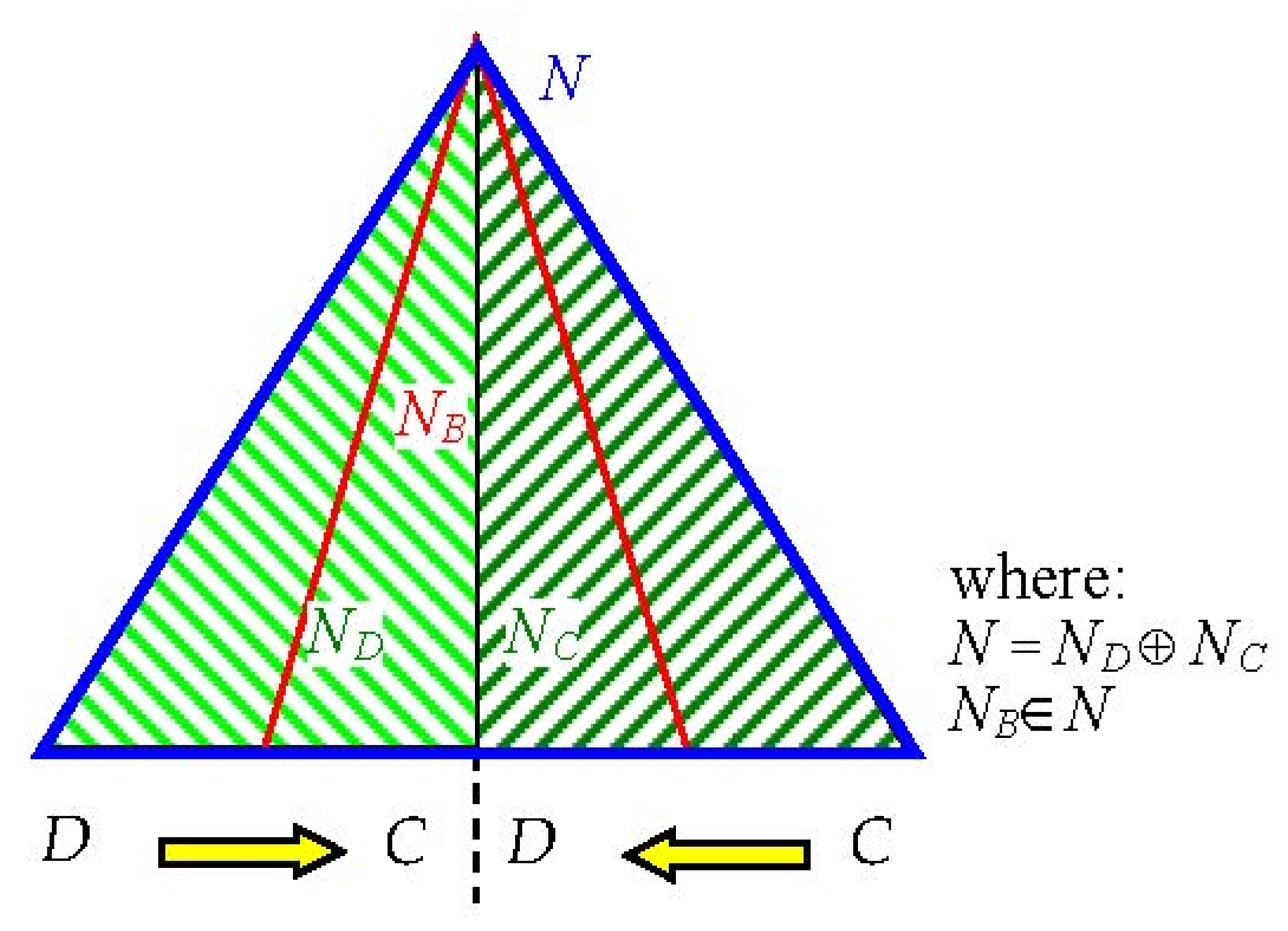
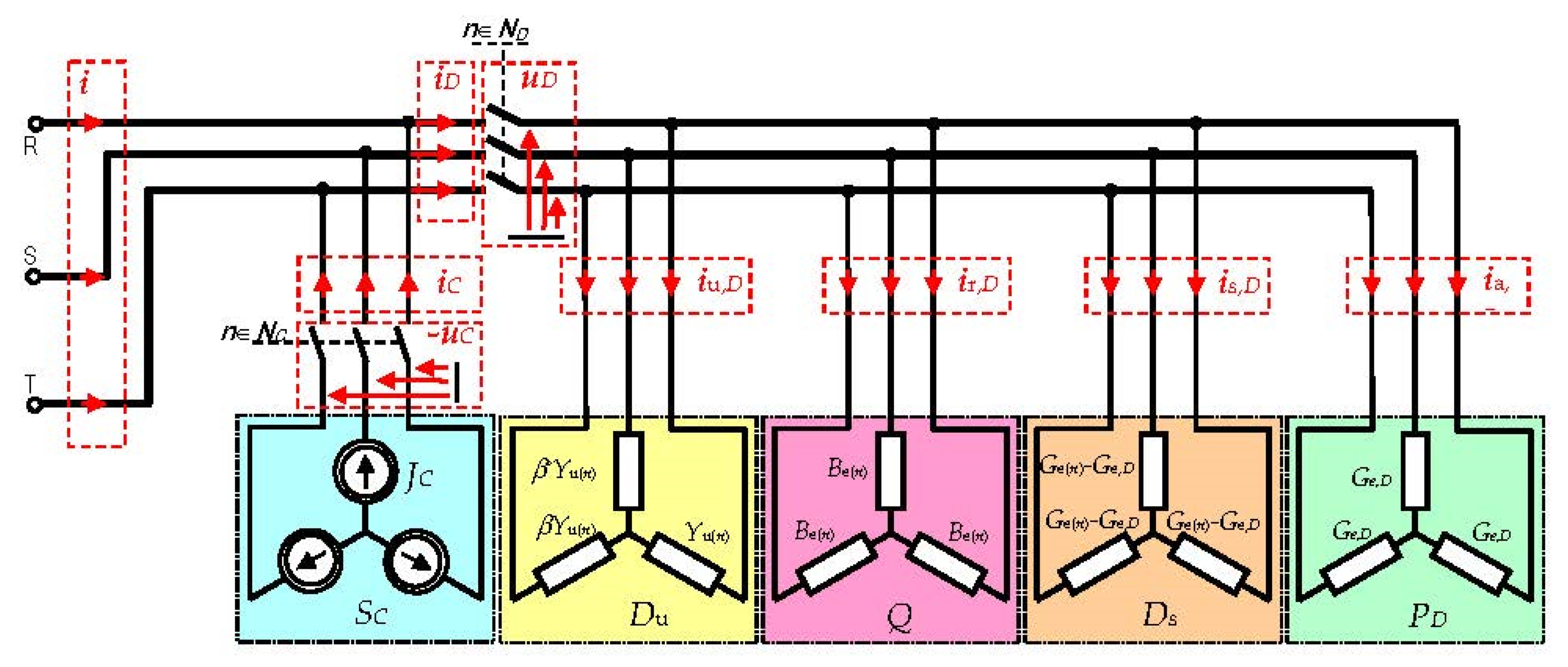
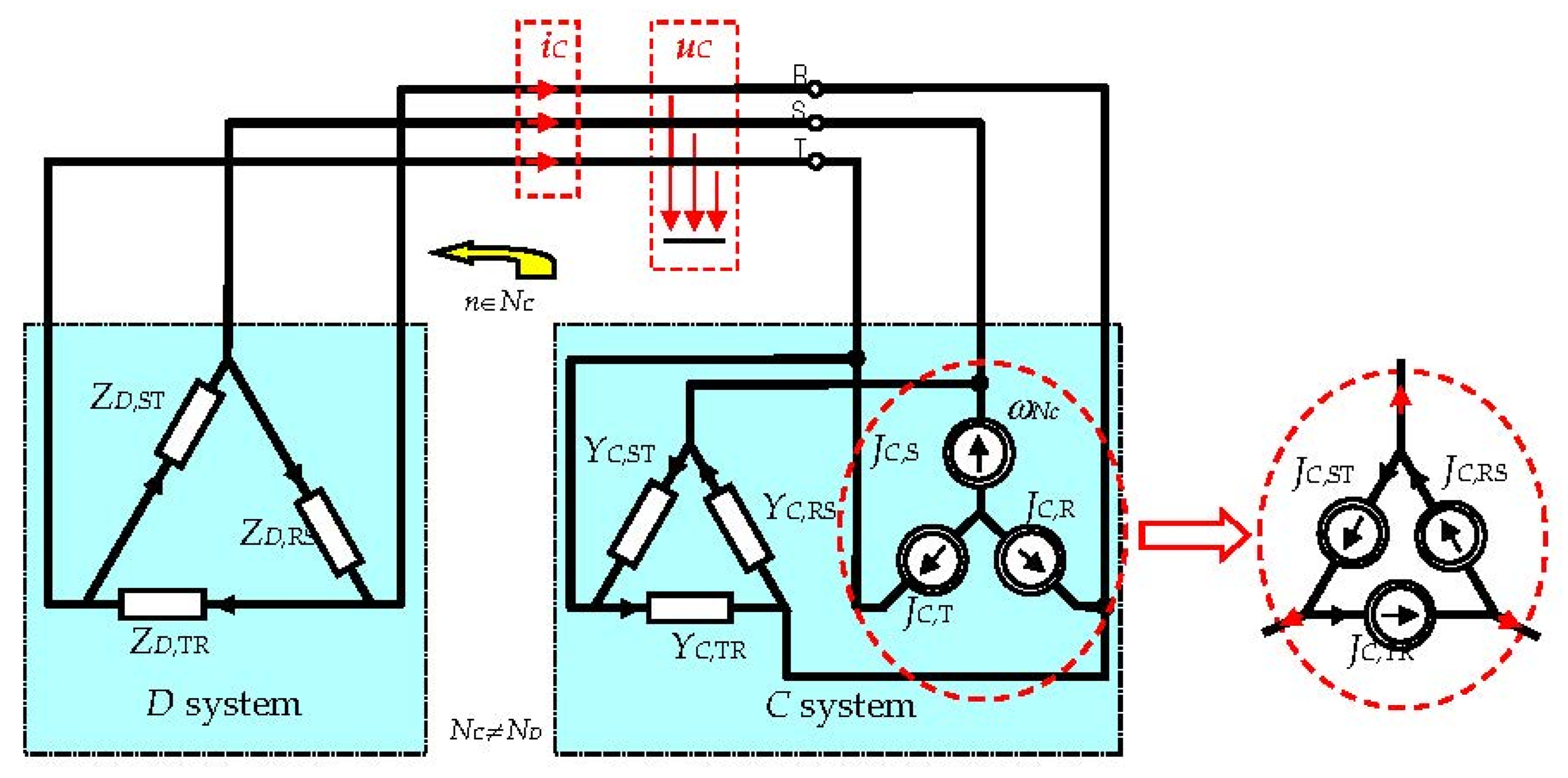
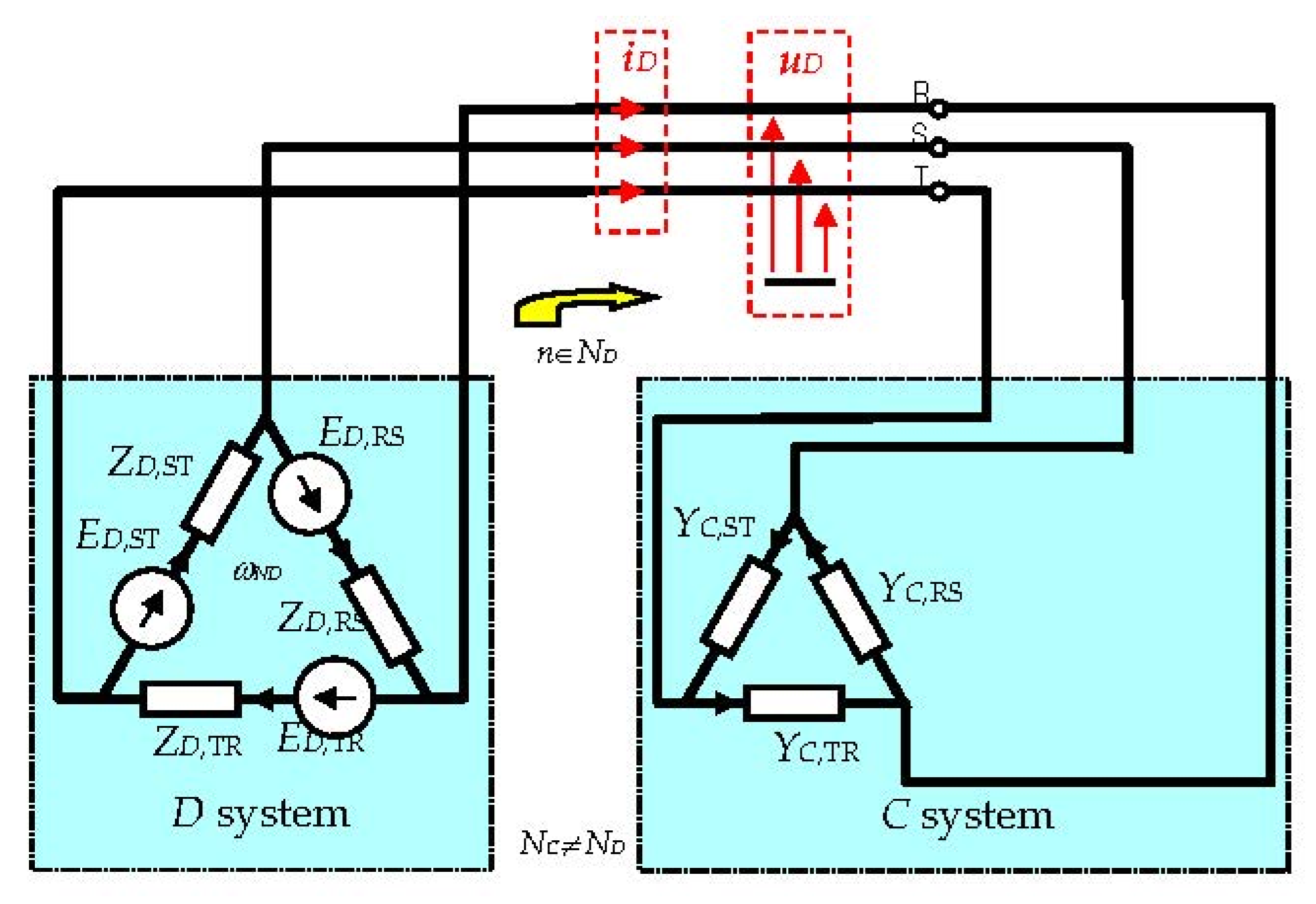
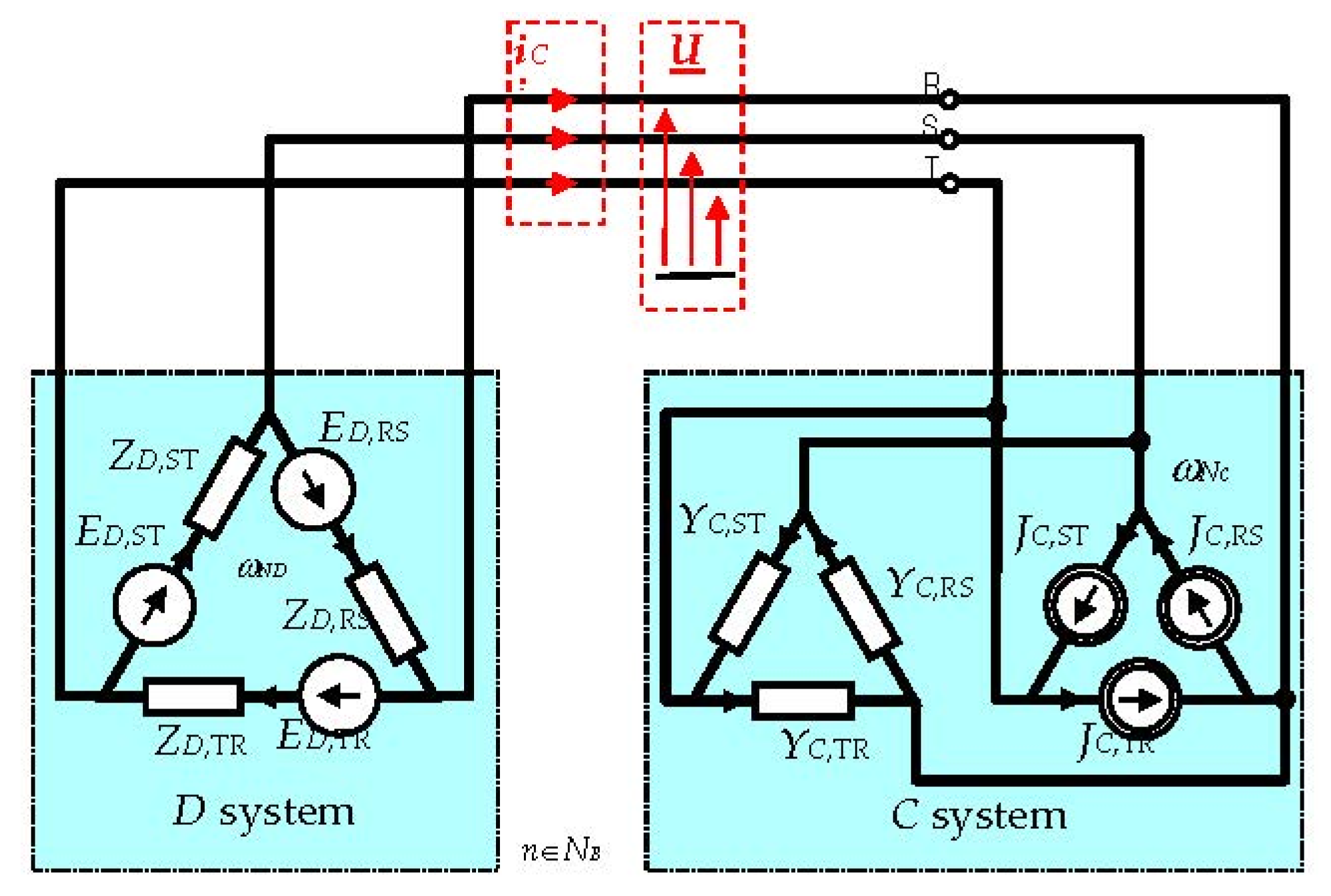
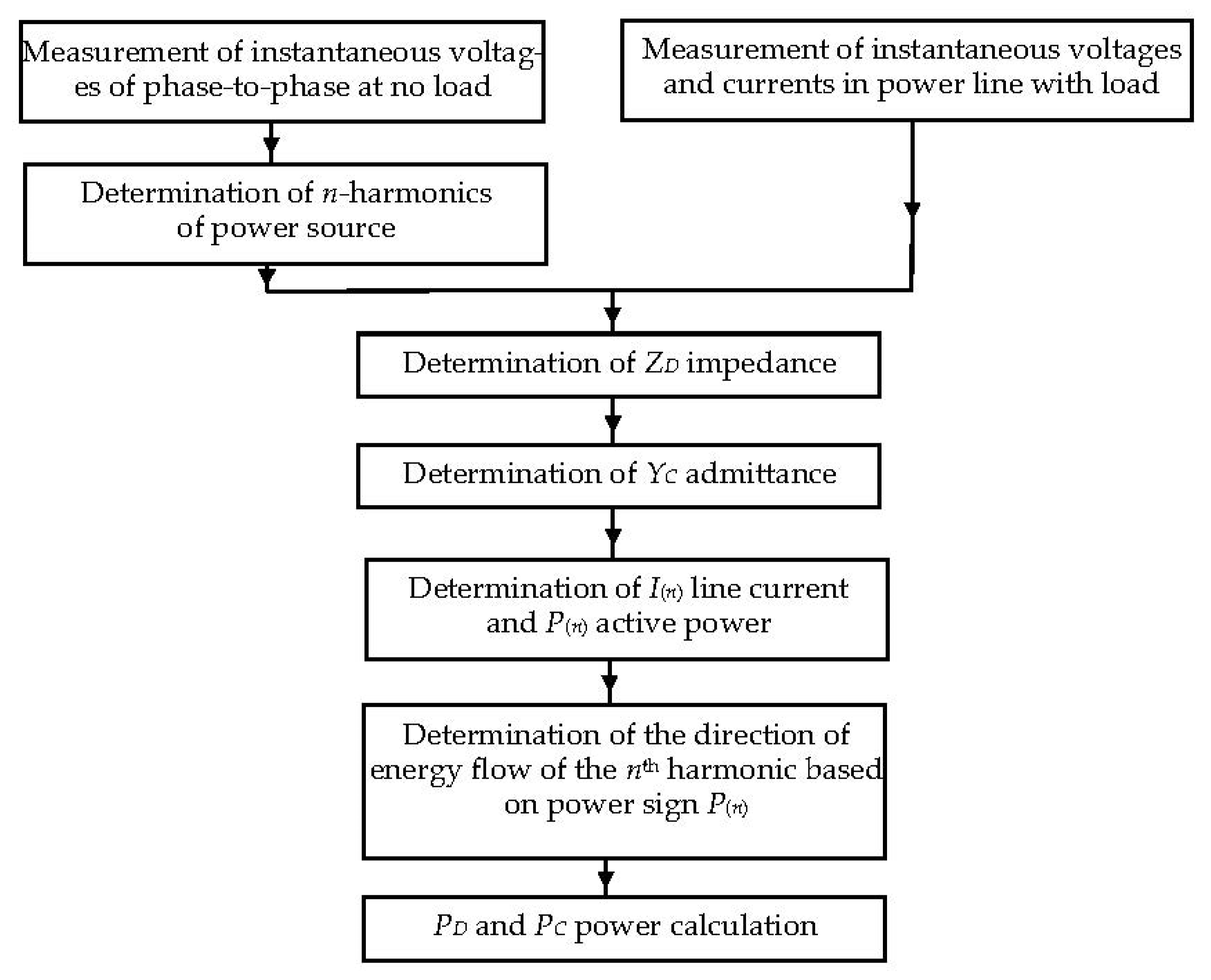
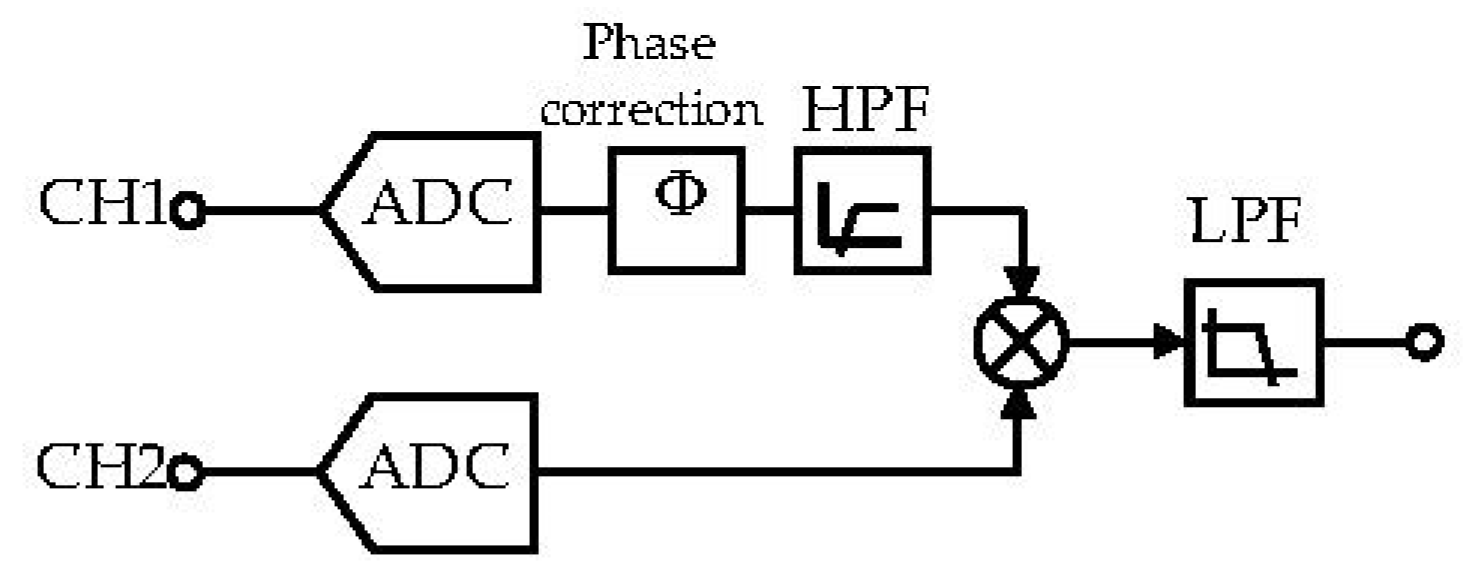
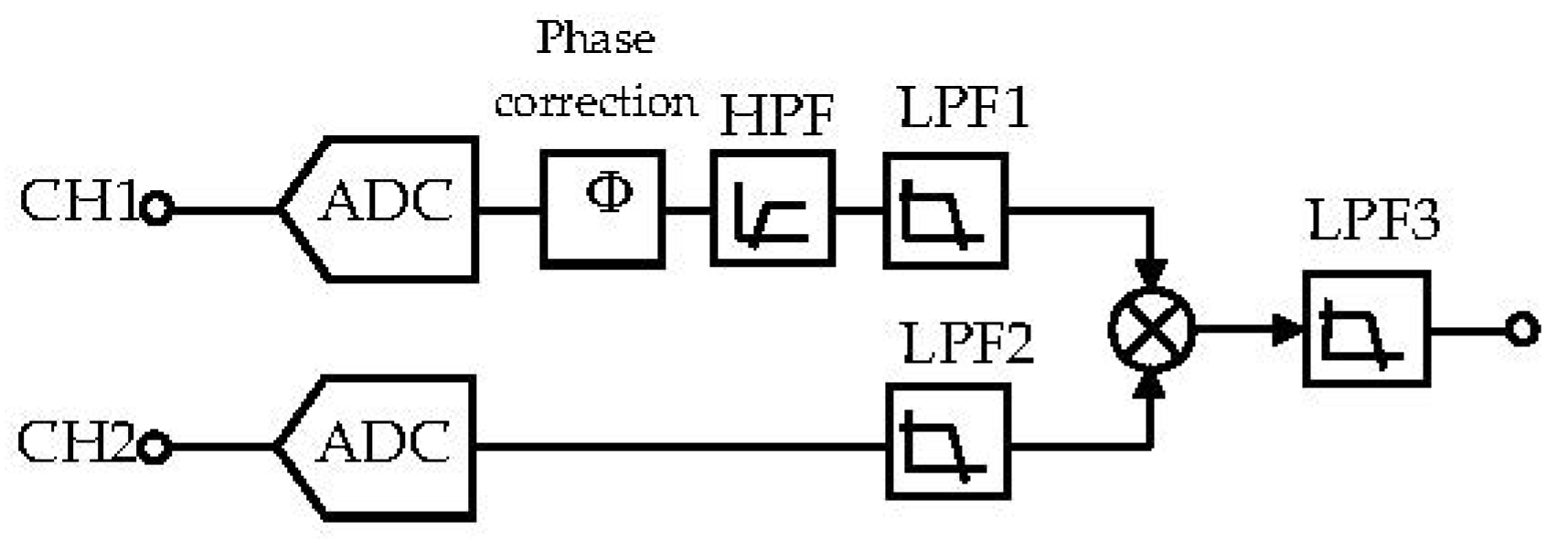
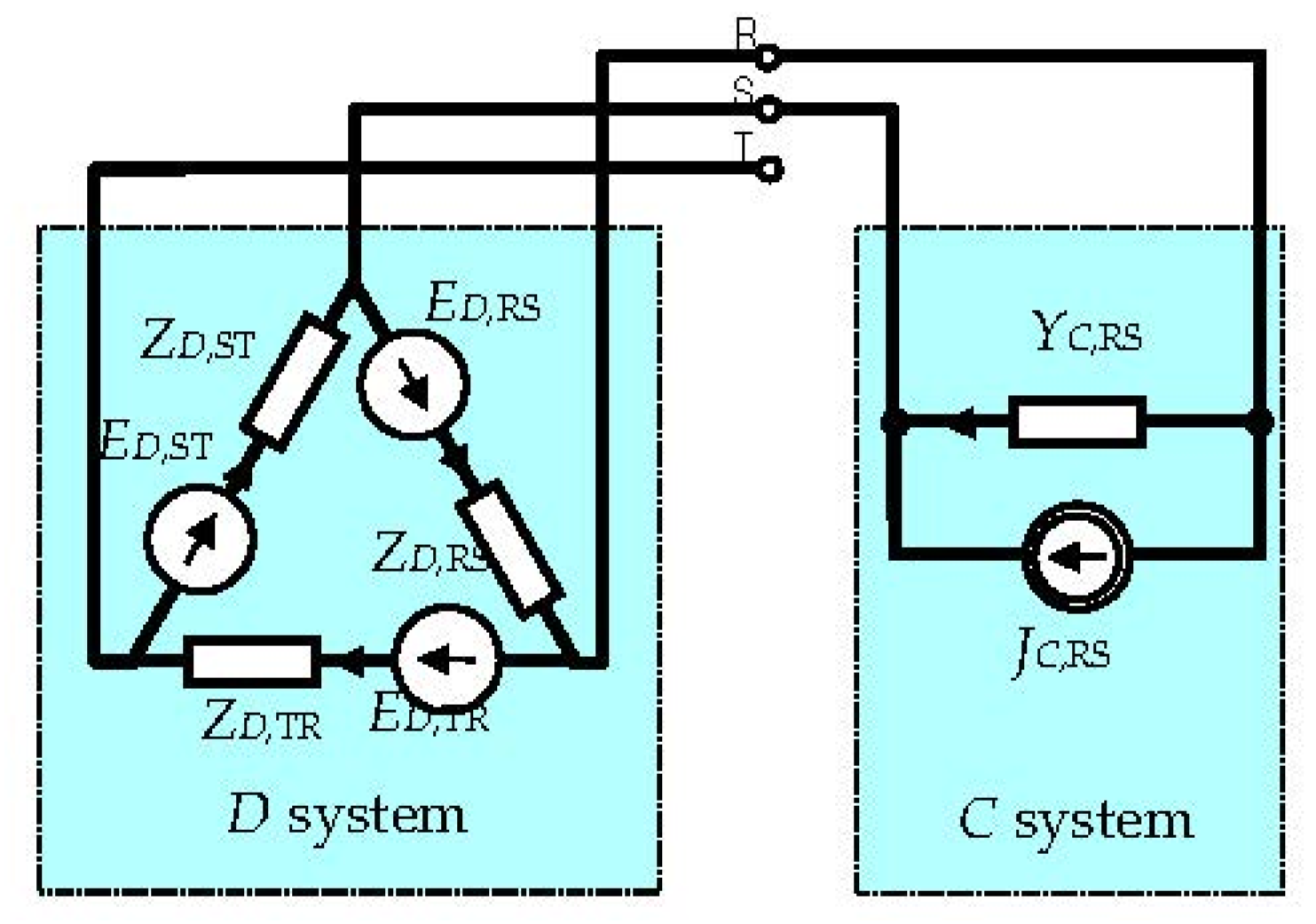
| n | 1 | 2 | 5 | 7 |
|---|---|---|---|---|
| [Ω] | 0.01 + j0.05 | 0.01 + j0.1 | 0.01 + j0.25 | 0.01 + j0.35 |
| [S] | 5 − j5 | 2 − j4 | 0.3846 − j1.9231 | 0.2 − j1.4 |
| n | 1 ∈ ND | 2 ∈ NB | 5 ∈ ND | 7 ∈ NC |
|---|---|---|---|---|
| URS [V] | 172.83 − j26.59 | 55.48 − j6.96 | 20.15 − j1.04 | 0.03 − j0.47 |
| IR [A] | 731.21 − j997.11 | −93.14 + j235.85 | 5.74 − j39.16 | −2.66 − j0.05 |
| PRS [W] | 152.89∙103 | −6.81∙103 | 156.63 | −0.11 |
Disclaimer/Publisher’s Note: The statements, opinions and data contained in all publications are solely those of the individual author(s) and contributor(s) and not of MDPI and/or the editor(s). MDPI and/or the editor(s) disclaim responsibility for any injury to people or property resulting from any ideas, methods, instructions or products referred to in the content. |
© 2023 by the authors. Licensee MDPI, Basel, Switzerland. This article is an open access article distributed under the terms and conditions of the Creative Commons Attribution (CC BY) license (https://creativecommons.org/licenses/by/4.0/).
Share and Cite
Zajkowski, K.; Duer, S.; Paś, J.; Pokorádi, L. Cooperation of a Non-Linear Receiver with a Three-Phase Power Grid. Energies 2023, 16, 1418. https://doi.org/10.3390/en16031418
Zajkowski K, Duer S, Paś J, Pokorádi L. Cooperation of a Non-Linear Receiver with a Three-Phase Power Grid. Energies. 2023; 16(3):1418. https://doi.org/10.3390/en16031418
Chicago/Turabian StyleZajkowski, Konrad, Stanisław Duer, Jacek Paś, and László Pokorádi. 2023. "Cooperation of a Non-Linear Receiver with a Three-Phase Power Grid" Energies 16, no. 3: 1418. https://doi.org/10.3390/en16031418
APA StyleZajkowski, K., Duer, S., Paś, J., & Pokorádi, L. (2023). Cooperation of a Non-Linear Receiver with a Three-Phase Power Grid. Energies, 16(3), 1418. https://doi.org/10.3390/en16031418









